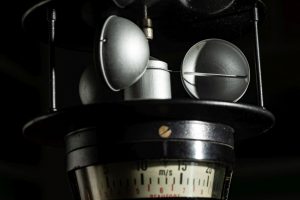January
| Hand-held cup anemometer used in the past for terrain measurement of wind speed based on rotation frequency. |  |
| The cup anemometer uses the angular rotation speed of a rotor consisting of cups arranged symmetrically around a usually vertical axis of rotation to measure wind speed. The first cup anemometer dates from 1837 by W. Whewell and was substantially improved by the Irish natural scientist J. T. R. Robinson in 1846. The basis of the bowl anemometer system is a rotor consisting of three or four cups, which are placed with their sides convex with respect to the direction of rotation on equally long arms at identical angular distances. In the 4-dish variant the rotor is known as a Robinson cross, but today the 3-dish variant is the predominant one, which is more convenient according to current knowledge. Due to their hemispherical or conical shape, the bowls impose approximately four times more resistance to the flowing medium with their hollow side than with their convex side, which causes the apparatus to rotate. The entire rotor body must be housed in good quality bearings to allow easy rotation with a low sensitivity threshold.
A bowl anemometer measures the component of wind speed perpendicular to the axis of rotation of the rotor. This is oriented vertically as standard and the instrument is therefore used to measure the horizontal component of the wind speed. To measure the wind direction, it is usually accompanied by a wind direction finder. Together with ultrasonic anemometers, this is the most widely used type of anemometer. Source: Česká meteorologická společnost [online]: Elektronický meteorologický slovník (eMS) [cit 21.12.2023]. Dostupné z: http://slovnik.cmes.cz |
|
In 1957, a meteorological sector was established within the Geophysical Institute of the Czechoslovak Academy of Sciences, consisting of the Department of Physics of the Earth's Atmosphere and the Department of Climatology and Short-Term Forecasting. From 1 January 1961 the meteorological sector was transformed into the Laboratory of Meteorology of the CSAV under the direction of A. Gregor. On 1 January 1964, the Laboratory was transformed into an independent Institute of Atmospheric Physics of the Czechoslovak Academy of Sciences, whose director was J. Podzimek.
The basis of today's Czech Hydrometeorological Institute was established between 1919 and 1920, when the State Meteorological Institute was founded under the Ministry of Education and National Enlightenment and the State Hydrological Institute under the Ministry of Public Works (for the first year the institutes used the names Czechoslovak State Meteorological Institute and Czechoslovak State Hydrological Institute).
The State Meteorological Institute was located until 1940 at 3 U Karlova Street (now Ke Karlovu 3), where the Faculty of Mathematics and Physics of Charles University is located. Its first director was Dr. Rudolf Schneider. In 1939-1945 it was called the Central Meteorological Institute for Bohemia and Moravia (ÚMÚ) and after World War II until 1953 the State Meteorological Institute (SMÚ).
Government Decree No 96/1953 Coll. of the Czechoslovak Republic, effective from 1 January 1954, included the field of hydrology and created the Hydrometeorological Institute (HMÚ), although the Water Research Institute (VÚVH) remained independent. In 1967, a third field, the protection of clean air, was incorporated into the Institute in response to the growing importance of environmental protection. After the proclamation of the federation, in 1969 it was divided into the Hydrometeorological Institutes with headquarters in Prague and Bratislava, which were then renamed the Czech Hydrometeorological Institute (ČHMÚ) and the Slovak Hydrometeorological Institute (SHMÚ).
Source: „Český hydrometeorologický ústav.“ Wikipedie: Otevřená encyklopedie.
The wind speed of 57.8 m/s is historically the highest wind speed measured in the Czech Republic. It occurred during a wind storm named after the pressure low Kyrill, which caused considerable damage in western and central Europe. At the Sněžka meteorological station on the Polish side of the border, a maximum wind speed of 60.0 m/s was recorded.
Digisonde Portable Sounder 4D (DPS 4D) is a vertically oriented radar instrument capable of making measurements of the overhead ionosphere and providing real-time on-site processing and analysis to characterize radio signal propagation to support communications or surveillance operations. The system compensates for a low power transmitter by employing intrapulse phase coding, digital pulse compression and Doppler integration. The data acquisition, control, signal processing, display, storage and automatic data analysis functions have been condensed into a single multi-tasking, multiple processor computer system, while the analog circuitry has been condensed and simplified by the use of reduced transmitter power, wide bandwidth devices, and commercially available PC expansion boards (https://ulcar.uml.edu/digisonde.html).
We consider 23 January 1890 as the date of the establishment of the purely Czech Academy of Sciences, when it was authorized by Emperor Franz Joseph I. In his honour, it was named the Emperor Franz Joseph Czech Academy for Sciences, Literature and Arts. However, it was mainly the architect Josef Hlávka who was responsible for its creation, as he financially secured it. The institution was housed in the newly constructed building of the National Museum on Wenceslas Square and began its activities on 18 May 1891. After the establishment of Czechoslovakia in 1918, the institution was renamed the Czech Academy of Sciences and Arts. In 1952, it was merged with other academic institutions to form the Czechoslovak Academy of Sciences.
 Sydney Chapman was a British mathematician and geophysicist, who contributed significantly into kinetic theory of gases and solar-terrestrial physics. He followed several distinct lines of research, each for periods extending over a number of years, though not continuously; often several different lines were being pursued simultaneously. His studies of the upper atmosphere, concerned diffusion and its effect on the damping of sound waves. He gave a first estimate of the electrical conductivity of the ionosphere. His geomagnetic works delt with the interpretation of the solar and lunar diurnal geomagnetic variations in terms of a ‘dynamo’ theory. He determined the effect of changes in ionospheric conductivity in increasing Lunar tide in summer as compared with winter, and also at times of enhanced magnetic activity. He made a study of Sq, the solar variation on magnetically quiet days. Further he contributed to the theory of atmospheric tides. He was working on theories explaining magnetic storms as produced by streams of charged particles emitted from the Sun and proposed explanation of geomagnetic storm initial and main phases. He divided the geomagnetic storm variations into a storm-time variation independent of the longitude and a local-time variation. In 1931 he introduced the theory of the ionospheric layer formation where he broke new ground by considering the mechanism of formation of ionized layers in the atmosphere by solar ultraviolet radiation. He assumed an atmosphere of uniform temperature, ionized by monochromatic radiation, and deduced a layer structure closely resembling that of the actual E-layer. He also considered problems of the photochemistry of atmospheric oxygen. Despite completely inadequate information as to absorption coefficients, the temperature of the upper atmosphere, and the intensity of solar ultraviolet radiation, he correctly found that atmospheric oxygen must be mainly atomic above a height of about 100 km. He also showed that the proportion of ozone in the atmosphere must have a maximum, at a height which he estimated as about 60 km (more recent work would decrease this height). He suggested that the green line in the spectrum of the airglow and aurorae originates in excitations of atomic oxygen when three oxygen atoms collide and two combine into a molecule, leaving the third excited. This suggestion (now generally accepted) was taken further in 1936 in a report written jointly with W. C. Price, in which they also showed that atomic nitrogen is only a minor constituent of the upper atmosphere, and considered the dissociation of water vapour. In 1960 he shortly visited Prague. (https://royalsocietypublishing.org/doi/pdf/10.1098/rsbm.1971.0003)
Sydney Chapman was a British mathematician and geophysicist, who contributed significantly into kinetic theory of gases and solar-terrestrial physics. He followed several distinct lines of research, each for periods extending over a number of years, though not continuously; often several different lines were being pursued simultaneously. His studies of the upper atmosphere, concerned diffusion and its effect on the damping of sound waves. He gave a first estimate of the electrical conductivity of the ionosphere. His geomagnetic works delt with the interpretation of the solar and lunar diurnal geomagnetic variations in terms of a ‘dynamo’ theory. He determined the effect of changes in ionospheric conductivity in increasing Lunar tide in summer as compared with winter, and also at times of enhanced magnetic activity. He made a study of Sq, the solar variation on magnetically quiet days. Further he contributed to the theory of atmospheric tides. He was working on theories explaining magnetic storms as produced by streams of charged particles emitted from the Sun and proposed explanation of geomagnetic storm initial and main phases. He divided the geomagnetic storm variations into a storm-time variation independent of the longitude and a local-time variation. In 1931 he introduced the theory of the ionospheric layer formation where he broke new ground by considering the mechanism of formation of ionized layers in the atmosphere by solar ultraviolet radiation. He assumed an atmosphere of uniform temperature, ionized by monochromatic radiation, and deduced a layer structure closely resembling that of the actual E-layer. He also considered problems of the photochemistry of atmospheric oxygen. Despite completely inadequate information as to absorption coefficients, the temperature of the upper atmosphere, and the intensity of solar ultraviolet radiation, he correctly found that atmospheric oxygen must be mainly atomic above a height of about 100 km. He also showed that the proportion of ozone in the atmosphere must have a maximum, at a height which he estimated as about 60 km (more recent work would decrease this height). He suggested that the green line in the spectrum of the airglow and aurorae originates in excitations of atomic oxygen when three oxygen atoms collide and two combine into a molecule, leaving the third excited. This suggestion (now generally accepted) was taken further in 1936 in a report written jointly with W. C. Price, in which they also showed that atomic nitrogen is only a minor constituent of the upper atmosphere, and considered the dissociation of water vapour. In 1960 he shortly visited Prague. (https://royalsocietypublishing.org/doi/pdf/10.1098/rsbm.1971.0003)
